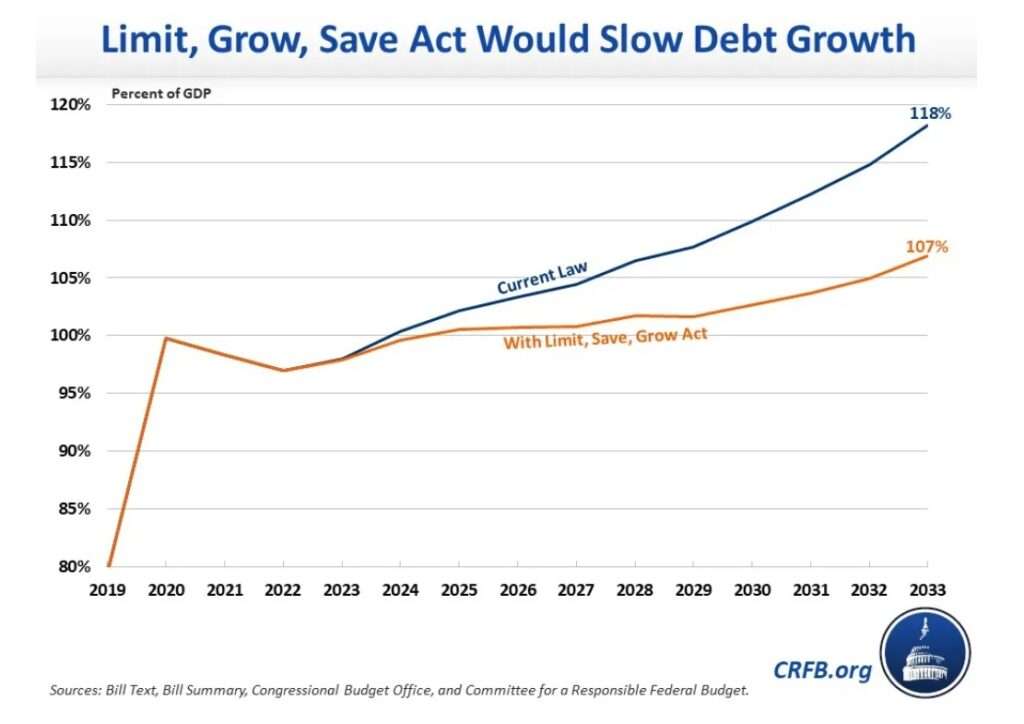
With budget deficits rising to unsustainable levels and the federal debt limit becoming a dangerous political hot potato, Congress and the White House struck a deal to limit the growth of future spending.
That was 12 years ago. But the spending caps imposed as part of the Budget Control Act of 2011—while imperfect, occasionally bent, and eventually discarded by the very Republicans who originally championed them—essentially worked: From 2012 through 2015, annual federal budget deficits fell from over $1.2 trillion to about $430 billion, the lowest level recorded since 2007. The election of President Donald Trump snuffed out Republican interest in fiscal restraint, but the theory that guided those few years of budgeting remains strong. To best way to stop Congress from approving massive amounts of borrowing to fund an overextended federal budget is to put some artificial limits in place.
Which brings us to the Limit, Save, Grow Act of 2023, the Republican-backed framework for a debt ceiling agreement. Speaker of the House Kevin McCarthy (R–Calif.) unveiled the bill last week. If passed, it would do a lot of little things to help reduce federal spending, such as blocking student debt forgiveness, undoing some recently created green energy tax credits, and revoking the huge budget increase given to the IRS last year. Those are all worthwhile ideas.
The bill would also do one really big, very important thing: reinstate some limits on Congress's ability to spend and spend and spend.
Specifically, the proposal would reset the federal budget baseline to where it was last year—that is, before the December passage of the $1.7 trillion omnibus bill that jacked up spending across the board—and would limit future budget growth to one percent annually for the next decade.
Of the roughly $4 trillion that would be saved over the next 10 years under the Republican plan, about $3.2 trillion of those savings come from the proposed limits on discretionary spending, according to the Committee for a Responsible Federal Budget (CRFB). The group's analysis of the Republican proposal finds that the national debt "would rise only about half as fast as currently projected" if Congress were to impose and abide by the discretionary spending limits in the proposal.

While we wait for more detailed analyses from the Congressional Budget Office and the Wharton Budget Model, the CRFB's assessment of the Limit, Save, Grow Act is an encouraging sign. The group calls the package a "welcome step in the right direction" and says the bill would "help the Federal Reserve fight inflation in the near term and generate significant savings at a time when they're desperately needed."
The Republican proposal is already being subject to misleading attacks that claim the spending caps would result in "cuts," even though the federal budget would continue to grow. The National Education Association, for example, is asking members to oppose what it calls "devastating cuts of 22 percent or more in essential government programs."
That's utter nonsense. Even after the $130 billion cut that would be necessary to bring federal spending back to last year's levels, the bill would set 2023's budgetary authority at levels that are 40 percent higher than they were in 2017. That's a giant increase in government spending over just seven years and a nice illustration of the wildly unsustainable course that the federal budget has been following.
And of course, spending will continue to grow in future years—though perhaps not as quickly as some special interests would like.
Artificial constraints on spending and borrowing are imperfect tools. Even if the Limit, Save, Grow Act becomes law—which is a long shot right now—future Congresses will be able to discard the discretionary spending caps at will. Like all the rules that govern how lawmakers can operate, they are only as good as the willingness to obey them.
But recent history suggests they're better than nothing. Budget deficits are on an unsustainable course, and the debt ceiling is a major issue. It's time for Congress and the White House to impose new spending caps.
The post The House GOP Debt Ceiling Plan Would Restore Spending Caps. Good. appeared first on Reason.com.







